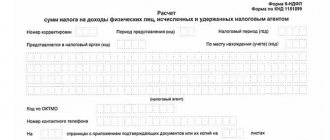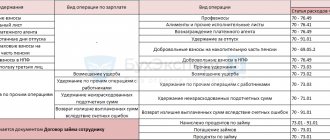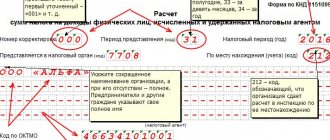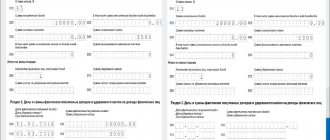The responsibility for mentioning taxes withheld from employee salaries lies with the accounting department of the organization. However, not every novice financier knows how to reflect alimony in 6 personal income taxes .
The rules for document execution are regulated by the order of the Federal Tax Service of the Russian Federation of 2015. According to the law, the paper must contain all payments to employees and their wages for the reporting period. Information about alimony payments in the financial document is indicated in field 130.
Alimony in 6 personal income taxes: procedure for withholding obligations
The employer has the right to withhold funds from the employee’s salary and transfer them to other citizens on the basis of the following documents:
- writ of execution handed over to the employer by the bailiff service;
- a voluntary agreement drawn up between an employee of an organization and another person entitled to receive salary.
According to federal law, when calculating the amount of alimony payments, the following types of income are taken into account:
- salary;
- allowances and bonuses;
- vacation funds;
- unemployment benefits;
- sick leave payments;
- reimbursement for meals;
- motivational and compensation payments;
- remuneration to the classroom teacher for leading a school class;
- payments to health workers for receiving citizens;
- journalistic, author or writer's fees;
- payments for work in particularly difficult conditions;
- scholarship;
- pension accruals;
- profit from business activities;
- profit from the rental of real estate;
- dividends from financial institutions;
- profit from the sale of copyrighted objects.
The timing of collection of funds from an employee directly depends on the document that is the basis for paying alimony:
- If the basis is a writ of execution, the employer undertakes to collect the required amount and transfer it to the recipient no later than three days after payment of wages or other income.
- If the basis is a voluntary agreement between citizens, then the terms of payment of maintenance are set out directly in this agreement.
Alimony as a type of deduction from wages
The concept of alimony includes those funds that are withheld, for example, from parents in court for the maintenance of their minor children.
The settlement department of the organization in which the person obligated to pay alimony works must withhold the awarded amount from the employee’s income on a monthly basis. Alimony is collected from the moment the writ of execution is received - the collection period is also indicated there. The list of types of wages and other income from which alimony is withheld for minor children is approved by Decree of the Government of the Russian Federation dated July 18, 1996 No. 841. In particular, alimony is withheld from salaries, additional payments, bonuses, etc.
ConsultantPlus experts explained how to calculate personal income tax when paying alimony. Get free demo access to K+ and go to the Ready Solution to find out all the details of this procedure.
As a result: algorithm for entering alimony into personal income tax certificate 6 and what income to take into account
According to the law, the accounting department of the company must deal with the issue of generating reporting documentation. These employees undertake to independently calculate the amount of alimony payments and transfer them to citizens who are indicated as recipients in the writ of execution from the bailiffs or in the agreement between the child’s parents. A complete list of earnings to be taken into account when calculating the amount of alimony payments is available in Government Decree No. 841 of 1996.
Video on the topic
Did you like the article?
Reflection of alimony in the 6-NDFL report
The issue of reflecting alimony concerns, as a rule, field 130 of the 6-NDFL report. This line reflects all income received by the taxpayer from which the organization withholds tax.
First, let's figure out exactly how income is reflected here. According to the order of the Federal Tax Service, which approved this form, this column must reflect the entire amount of income received by taxpayers without deducting taxes withheld or deductions provided. That is, the amount that will be reflected in 2-NDFL.
Read more about filling out line 130 in our article “Procedure for filling out line 130 in form 6-NDFL”.
Deductions (in particular, alimony) from the income of an individual do not reduce the tax base for personal income tax. This follows from Art. 210 Tax Code of the Russian Federation. Accordingly, the company will first accrue the employee’s income, calculate the tax, and then calculate alimony. And the employee will receive the amount minus tax and alimony.
The general principles for calculating and withholding personal income tax can be found in the material “General procedure for calculating and paying personal income tax.”
This means that on line 130 the company will reflect the amount that was accrued and not given to the employee.
If you submitted a report to the inspectorate and indicated in line 130 the amount minus alimony, then you must submit an updated report with the correct full income of the taxpayer. Otherwise, there is a high risk of imposing a fine on the company for providing false information - 500 rubles.
For more information on when and how to correctly submit corrective information for 6-NDFL, read this article.
Results
Before submitting the report, it is important to check the control ratios according to the methods of the tax authorities. The check must be performed using the calculation of contributions and the numbers in section 1 of form 6-NDLF.
Benchmarks to check:
- page 20 – page 25 in form 6 personal income tax ≤ page 050 of section 1 subsection 1.1 of accounting for insurance premiums.
If discrepancies occur, an explanation may be required to indicate the reason for the discrepancy. The explanatory note must be drawn up in the form and submitted within a certain time frame.
Is the amount won in court subject to alimony and income tax?
As for the money that you must be paid by court decision, for example, moral compensation or compensation for damage to property or health, their taxation with alimony and tax depends on the following factors:
- whether the amount won relates to income from the Government’s list No. 841;
- Is this amount recognized as taxable income under Chapter 23 of the Tax Code of the Russian Federation?
For example, such a form of winning as paying off a debt (your debt was returned to you through the court) is not subject to tax and money for the family.
Deduction of personal income tax and alimony
Column 130 of the report reflects all types of accrued income to employees of the organization without taking into account applied deductions. Collections from wages do not reduce the tax base for calculating income tax. The calculation method requires first calculating the tax, and only then deductions for minor children are calculated. The individual is due payment in person minus personal income tax and alimony.
In case of incorrect reflection of the amount in line 130 of the 6 personal income tax report, updated calculations should be submitted with the correct reflection of the total amount of income.
Taxpayer status when transferring alimony
Payment of alimony is not a tax payment, which is paid into a non-budget system.
The Ministry of Finance has developed rules for filling out payment slips only for money transfers to the budget (Order of the Ministry of Finance of Russia No. 107n dated November 12, 2013):
- taxes;
- insurance premiums;
- fees;
- customs payments, etc.
In Appendix No. 5 to this order there is a list of statuses from two-digit codes, which must be entered in field 101.
But, since the transfer of alimony is a transfer not to the state budget, these rules in the preparation of a payment order do not apply to it, and nothing is entered in the payer status; the field remains empty.
In this case, the “Purpose of payment” field contains information:
- the purpose of the payment is the transfer of alimony;
- object of deduction - from the salary, full name of the employee;
- employee tax identification number;
- for what period is the transfer;
- basis - number and date of the writ of execution.
The procedure for deducting alimony from an employee’s salary
The employer calculates and withholds alimony, and also transfers the established amounts to the recipient on the basis of executive documents, which can be:
- writ of execution received from the bailiff;
- a voluntary agreement concluded between the employee (the alimony payer) and the claimant.
The basis for calculating alimony is the income received by employees during the reporting month, namely:
- salary;
- allowances, bonuses;
- vacation pay;
- benefits for the period of temporary incapacity for work on sick leave;
- reimbursement of the cost of lunches;
- other motivational payments and compensations that are recognized as an element of remuneration.
If the basis for withholding is a writ of execution, then the employer is obliged to collect and pay alimony to the recipient no later than three days from the date of payment of the remuneration. When withholding alimony on the basis of a voluntary agreement, the employer is guided by the procedure and timing of collections and payments provided for in this agreement.
Deduction of personal income tax and alimony
Column 130 of the report reflects all types of accrued income to employees of the organization without taking into account applied deductions. Collections from wages do not reduce the tax base for calculating income tax. The calculation method requires first calculating the tax, and only then deductions for minor children are calculated. The individual is due payment in person minus personal income tax and alimony.
In case of incorrect reflection of the amount in line 130 of the 6 personal income tax report, updated calculations should be submitted with the correct reflection of the total amount of income.
Withholding alimony for personal income tax purposes
Whether alimony is taxable by law, to understand this issue it is necessary to understand the general concepts.
The legislator defined the term alimony as material resources that one person, based on family relationships, is obliged to pay to another.
Ordinary people believe that payments are made only by the father or mother to meet the needs of the child, but this is not so. There are also alimony relationships between other relatives (grandmother - grandson, stepfather - stepdaughter, etc.).
The issue of financial support is resolved between individuals in a voluntary format, by signing an agreement with a notary, or through a judicial process. Then the court establishes the amount and procedure for such payments.
Subsequently, they are collected from the person liable for alimony at the expense of his income and other property. In this case, regulatory requirements must not be violated.
According to Art. 137 of the Labor Code of the Russian Federation stipulates that any deductions from wages are subject to legal grounds only. There is also a limit on the amount of penalties.
As a general rule, it is allowed to withhold up to 50% of wages under writs of execution, but these norms do not apply to alimony for minors. Here the acceptable size is 70%.
That is, increased withholding is allowed for children, and for other persons (ex-spouses, relatives) only up to 50 percent.
Grounds for withholding funds for a child
The need to pay money to a minor arises when the organization of the alimony provider’s employer receives a writ of execution.
Funds for the child can be paid from the salary of any individual. A common point of view is that payments should be taken from the income of the father whose marriage has ended. However, today you can find more and more mothers obligated to pay alimony who are forced to pay money for a little person on an equal basis with men. The obligation to withhold funds is established by a court decision or an agreement concluded between the former spouses. You need to calculate and transfer money in accordance with these documents. They will indicate the percentage that is supposed to be collected from the payer’s income, or the exact amount.
The collection of alimony by the employer can be initiated by the bailiff, the debt collector and the employee himself. If an accountant ignores this legal requirement, he will be subject to administrative or even criminal liability. In view of this, the financier or the employer himself is obliged to know whether child support is taxed, what is the standard procedure for calculating the payment, and how the subordinate’s income is reflected in various certificates.
Which document is more important?
Questions also arise when several executive documents are received for one employee. Is it necessary to take on all the documents at once or is it more correct to organize a “queue” and begin execution of each next one only after the execution of the previous one is completed?
There is no direct answer to this question in Law No. 229-FZ. But there are two rules:
- Deductions must begin from the date of receipt of the writ of execution (Article of Law No. 229-FZ). This rule applies regardless of whether this is the first document for the employee or not.
- The employer distributes the collected amounts among the claimants without taking into account when which executive document was received (clause 3 of Article 111 of Law No. 229-FZ).
Thus, there is no need to queue enforcement documents: they must be executed simultaneously. As soon as a new resolution is received, it is necessary to immediately carry out deductions on it along with existing writs of execution.










